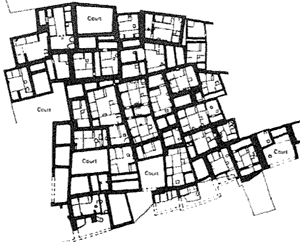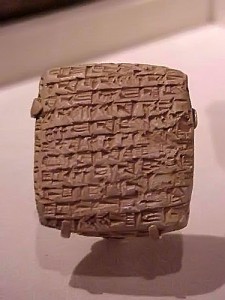Why is Neolithic Çatal Höyük not a city? Why is the Bronze Age trade centre of Kanesh a city? Is the difference just that large palace on the hill?
Çatal Höyük
Çatal Höyük, in southern Anatolia, Turkey, ranks as one of the earliest villages anywhere in the world. Dating back to the eighth millennium BC (in the Pre-Pottery Neolithic), Çatal Höyük was, for the time, vast, with a population of over five thousand people.
But no archaeologist would call it a town, let alone a city. This is only partly because it is too small. Ur, the mightiest city in the world three thousand years later, was only ten times bigger. The main reason it’s not called a town is because it has none of the trappings of a town. Indeed, it is more like a crowded suburb.
The remains of the houses of early Çatal Höyük are uniform and square, with ground floors consisting of one room. Some probably had second floors but it’s difficult to tell. There were no gardens, just buildings packed in, only separated by a few centimetres, with not even room for alleyways. Where are the temples, palaces and other public buildings? Apparently there were few or none, just these clustered square boxes.
Extending the suburban analogy further, these houses were well maintained, replastered regularly and kept very tidy. Some had reliefs of wildlife on their walls. And when finally knocked down, they were carefully replaced in exactly the same position.
Kanesh
Two hundred miles to the north-east, and much younger, there is another ancient settlement, the site of Kültepe, known at the time as the city of Nesha or Kanesh. This city was inhabited from the end of the third millennium (Middle Bronze Age) onward, but reached some kind of peak between 2000 and 1700 BC (depending on whose dates you believe).
There are two parts to this city – a main mound or citadel, containing temples and a palace, and a smaller mound known as the Karum. What makes this city a city is the citadel. What makes it interesting is the Karum.
Archaeologically, the Karum looks more modern but not dissimilar to Çatal Höyük. It must have had a population of several thousand people. It seems to be made up entirely of uniform houses of a typically local style.
The houses are rectilinear and clustered together, although in this case there are occasional narrow streets between them. They are bigger than those of Çatal Höyük, with a minimum of two rooms and sometimes a central courtyard. Again, they probably had two floors. Like Çatal Höyük the Karum seems, from the archaeology, to contain no special buildings.
Tablets
None of this is that interesting, frankly. But what made the Karum so interesting to both archaeologists and historians was the discovery here of thousands of writing tablets. They revealed that the Karum was inhabited not just by locals. There was a substantial population of Assyrian private traders, living five hundred miles from their ancestral home, Assur, in northern Iraq.
What these traders traded out to Assur was local gold, silver, tin and copper. What they traded in was cloth and clothing (indeed it’s not unlike modern China’s trade with East Africa). Although the site contains some metal ornaments, both the trade and the presence of the traders could not have been told from the archaeological remains alone.
Absence of evidence
Archaeology does it’s best but it cannot overcome a fundamental weakness – that is the surprising ability of many people in the past to tidy up after themselves. A culture of recycling means that much is reused – even clay tablets can be ground up for use in pottery making.
The evidence for trade in Kanesh Karum comes largely from the tablets of one layer. These tablets were left when Kanesh Karum burned down and, presumably, the population ran away or were rounded up. If this hadn’t happened there would be little evidence to indicate any trade at all.
Çatal Höyük is from an earlier age where no-one could write anything anyway. Who knows what its inhabitants did? It’s generally assumed that, apart from occasionally decorating each other with tiny stamp patterns, they mostly farmed, hunted and gathered. Personally it seems that this densely populated suburb of nowhere is not well designed for such activities. Perhaps (and it’s a big perhaps) these people were traders from distant lands as well.
Now I’m not saying they would trade gold and fine wares in the same way, because mining hadn’t got going and people probably weren’t so sophisticated in their tastes as they were in the Bronze Age. But things still travelled long distances even back then.
Parasite Princes
Conventionally, ancient long-distance trade is viewed as a royal activity, confined to Princes and their servants. Only Princes could afford such luxury trade, hence long-distance trade only came into existence with the first Princes. It was only thousands of years of civilisation that freed up this system and made it possible for anyone else to do.
But perhaps that’s the wrong way round. Perhaps princes and kings are simply parasites which “evolved” to feed off the already thriving long-distance trade.
Currently it is unknown whether the building of the palace on the citadel at Kanesh started before or after activity in the Karum started. Personally I have no doubt that the traders in the Karum of Kanesh could have functioned quite well without the palace. The tablets hint that they had their own security, after all.
Now if Çatal Höyük were, say, a trading centre as well, this may give us a clue as to why it was seemingly so egalitarian. The missing “city” part of Çatal Höyük may be missing simply because no-one had yet been able to gather a nomadic horde and descend upon this village’s unsuspecting inhabitants. No-one had yet, through force, settled in a citadel beside the thriving village and took money and gifts from its inhabitants for no other reason than that they could.
Well… maybe.
References
Newton, M.W. & Kuniholm, P.I. 2004, A dendrochronological framework for the Assyrian colony period in Asia Minor, Anatolian Archaeological Studies 10, 125–127.
Sagona, A. & Zimansky, P.E. 2009 Ancient Turkey, Routeledge, pp408.
Çatal Höyük excavation website
Wikipedia – Kültepe.
Photo from MHarrsch’s Photostream on Flickr.




{ 0 comments… add one now }